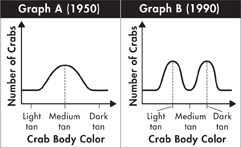Standardized Test Prep
Multiple Choice
Which of the following conditions is MOST likely to result in changes in allele frequencies in a population?
random mating
small population size
no migrations into or out of a population
absence of natural selection
Mutations and the genetic recombination that occurs during sexual reproduction are both sources of
genetic variation.
stabilizing selection.
genetic equilibrium.
genetic drift.
In a population of lizards, the smallest and largest lizards are more easily preyed upon than medium-size lizards. What kind of natural selection is MOST likely to occur in this situation?
genetic drift
sexual selection
stabilizing selection
directional selection
Populations of antibiotic-resistant bacteria are the result of the process of
natural selection.
temporal isolation.
genetic drift.
artificial selection.
If species A and B have very similar genes and proteins, what is probably true?
Species A and B share a relatively recent common ancestor.
Species A evolved independently of species B for a long period.
Species A is younger than species B.
Species A is older than species B.
When two species reproduce at different times, the situation is called
genetic drift.
temporal selection.
temporal isolation.
lateral gene transfer.
The length of time that two taxa have been evolving separately can be estimated using
genetic drift.
gene duplication.
a molecular clock.
Hox genes.
Questions 8–9
The graphs below show the changes in crab color at one beach.
What process occurred over the 40-year period?
artificial selection
directional selection
stabilizing selection
disruptive selection
Which of the following is MOST likely to have caused the change in the distribution?
A new predator arrived that preferred dark-tan crabs.
A new predator arrived that preferred light-tan crabs.
A change in beach color made medium-tan crabs the least visible to predators.
A change in beach color made medium-tan crabs the most visible to predators.
Open-Ended Response
How does evolution change the relative frequency of alleles in a gene pool? Why does this happen?
| Question | 1 | 2 | 3 | 4 | 5 | 6 | 7 | 8 | 9 | 10 |
|---|---|---|---|---|---|---|---|---|---|---|
| See Lesson | 17.3 | 17.1 | 17.2 | 17.2 | 17.4 | 17.3 | 17.4 | 17.2 | 17.2 | 17.1 |
Table of Contents
- Formulas and Equations
- Applying Formulas and Equations
- Mean, Median, and Mode
- Estimation
- Using Measurements in Calculations
- Effects of Measurement Errors
- Accuracy
- Precision
- Comparing Accuracy and Precision
- Significant Figures
- Calculating With Significant Figures
- Scientific Notation
- Calculating With Scientific Notation
- Dimensional Analysis
- Applying Dimensional Analysis





